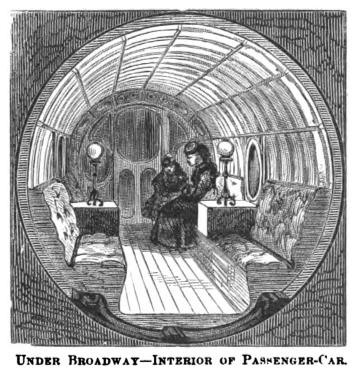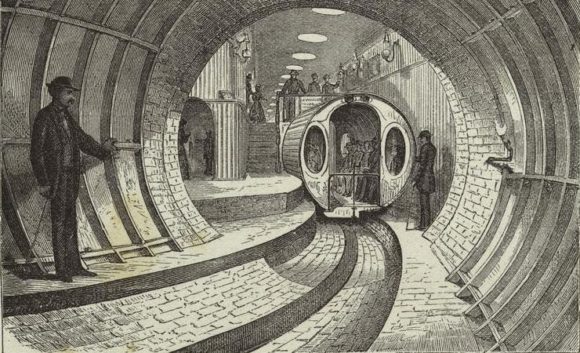Subway Lore: The 1870 Beach Pneumatic Transit
It was merely an experiment (one car, one station) but it lead to a future of subway transport.
Wouldn’t it be fantastic to find one of these old cars or the line itself somehow intact? Imagine a story about the Pneumatic Transit existing in a time warp right beneath our feet, complete with busy travelers from 1870… (and were there really fragile lamps balanced on little tables inside the cars?!)
“The Interborough Rapid Transit subway, which broke ground in 1900 after many years of political maneuvering, was not the first attempt at transit tunneling in New York City. Several other groups attempted to build tunnel lines with varying degrees of success.
Probably the most well known of these early attempts, at least in terms of subway lore, was an 1870 demonstration line, the Beach Pneumatic Transit. Alfred Ely Beach, inventor and editor of Scientific American, had designed a pneumatic (air-driven) system which he demonstrated at the American Institute Fair in 1867, and he thought it viable for transit operation in underground tunnels. He applied for a permit from the Tammany Hall city government, and after being denied, decided to build the line in secrecy, in an attempt to show that subterranean transit was practical. (He actually did receive a permit to built a pneumatic package delivery system, originally of two small tunnels from Warren St. to Cedar St., later amended to be one large tunnel, to “simplify construction” of what he really intended to build.)
The Beach tunnel was constructed in only 58 days, starting under Warren Street and Broadway, directly across from City Hall. The station was under the south sidewalk of Warren Street just west of the Broadway corner. The single track tunnel ran east into Broadway, curved south, and ran down the middle of Broadway to Murray Street, a distance of one block, about 300 feet in all. The subway opened to the public on February 26, 1870.
Operated as a demonstration from 1870 to 1873, the short tunnel had only the one station and train car. While frequently mentioned as an important early development in New York City’s transit history, it was merely a curiosity. It is unclear that such a system could have been practical on a large scale. Smaller tube systems are used in buildings for mail delivery, but a rail-car sized system has never been developed. The perfection of electric multiple-unit traction and electric locomotives came about so quickly after this experiment that it wasn’t deemed worthwhile to even try an expanded pneumatic system…”
For the rest, click here to go to nycsubway.org.
Share


